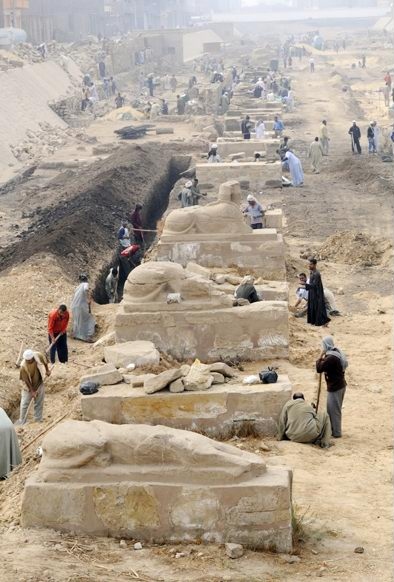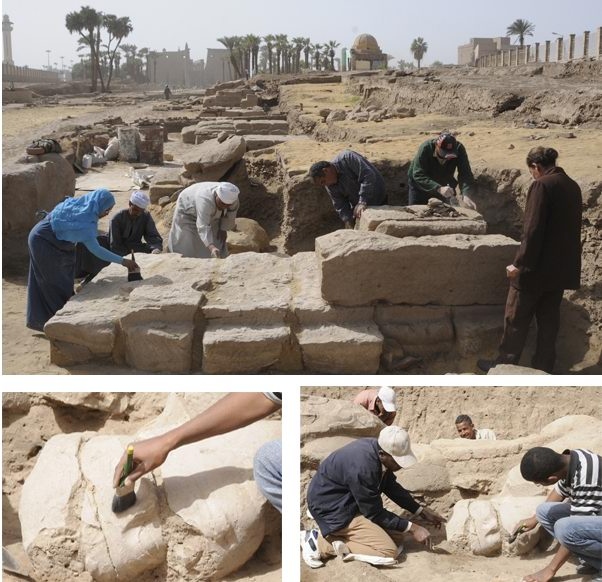
|
HiddenMysteries.com HiddenMysteries.net HiddenMysteries.org |
* * * * * * * * * * * * * * * * * * * * * * * * * * * * * * * * * * * * * * *
A word from our sponsor

Strolling on the avenue
Monday, February 15 2010 @ 02:40 AM CST
Increase font Decrease font
This option not available all articles
Tourists will soon be able to see two sections of the Avenue of Sphinxes in Luxor looking much as they did in the days of the Pharaohs. Nevine El-Aref takes a stroll down the path of priests and princes
The magnificent aspect of the Avenue of Sphinxes that once connected the temples of Luxor and Karnak, where priests, royalty and the pious walked in procession to celebrate the Opet festival, is being rekindled. Many of the 1,350 human-headed sphinxes with the bodies of lions that once lined the avenue have been restored.
On the annual Opet festival priests trod the paving stones from Karnak to Luxor bearing a wooden bark holding the shrine of the triad of deities: Amun-Re, Mut and Khonsu.
The 2,700-metre-long avenue of sphinxes was built during the reign of Pharaoh Nectanebo I of the 13th-Dynasty. It replaced one built formerly in the 18th Dynasty, as Queen Hatshepsut (1502-1482 BC) recorded on the walls of her red chapel in Karnak Temple. According to this, she built six chapels dedicated to the god Amun-Re on the route of the avenue during her reign, emphasising that it was long a place of religious significance.
Sadly, however, over the span of history the avenue was lost, subjected to destruction as some of its sphinxes were destroyed and those sections of the avenue that were far removed from both temples were covered with sand and were buried under random housing.
Within the framework of the Ministry of Culture programme to restore ancient Egyptian monuments with a view to developing the entire Luxor governorate into an open-air museum, a project was planned to recover the lost elements of the avenue, restore the sphinxes and return it to how it was in ancient Egypt.
To check on the work achieved in the two sections of the avenue that will be opened next month by President Hosni Mubarak, the minister of Culture, Farouk Hosni, and Zahi Hawass, secretary-general of the Supreme Council of Antiquities (SCA), last Monday embarked on an inspection tour of the site.
Hosni told reporters that developing the Avenue of Sphinxes was part of the collaboration between the ministry and the SCA with the Luxor governorate to develop the whole city into an open-air museum. He continued that the SCA had allocated the sum of LE30 million to remove all encroachments and compensate those who owned houses and shops along the route and had been removed, as well as a further LE30 million for excavation and restoration work.
Hosni explained that the work was carried out in three phases; the first was to build a low wall alongside the avenue in order to preserve it from any further encroachment, the second phase was the excavation, and the third was restoration of the area.
The excavation team unearthed a large number of fragmented sphinxes that are now undergoing restoration in an effort led by SCA consultant Mahmoud Mabrouk. Once restored, they will be placed on display along the avenue.
"It is really a great project and what has been achieved was like the way the Pharaohs worked," Hosni concluded.
Hawass told Al-Ahram Weekly that the avenue was divided into five excavation sections, each revealing more sphinxes as well as the cartouches of several kings and queens. Excavators have unearthed only 650 sphinxes of the original 1,350, since many were reused during the Roman period and the Middle Ages.
Archaeologists have unearthed a number of Roman buildings and workshops for the manufacture of clay pots and statues, as well as several reliefs. One of the reliefs bears the cartouche of the famous Queen Cleopatra VII (51-30 BC). "I believe that this queen likely visited this avenue during her Nile trip with Mark Anthony and implemented restoration work that was marked with her cartouche," Hawass asserted. He said that remains of Queen Hatshepsut's chapels, which were reused by the 30th- Dynasty Pharaoh Nectanebo I when the sphinxes were installed, have been found, along with the remains of Roman wine factories and a huge water cistern.
Mabrouk said the original avenue was now resurrected and would soon appear just as it was before, planted with species to match those that grew in ancient Egypt.
During this visit, Hosni and Hawass installed the piece of red granite belonging to the naos of Pharaoh Amenemhat I, who reigned from 1991 to 1962 BC in the Middle Kingdom, in its original place in the Temple of Ptah at Karnak.
This naos was returned to Egypt last October by the Metropolitan Museum of Art in New York. The museum purchased the piece from an antiquities collector in New York expressly in order to return it to Egypt.
Hawass described this action by the Metropolitan Museum as "a great deed", since it was the first time that a museum had acquired an object for the purpose of returning it to its country of origin. The action, Hawass claimed, highlighted the deep cultural cooperation between the SCA and the Metropolitan Museum, as well as the Met's determination to returning illegal antiquities to their homeland.
"It is also a kind gesture from the newly appointed Metropolitan director Thomas Campbell," said Hawass.
The recovery of the piece came after Dorothea Arnold, curator of the Egyptian section at the Metropolitan Museum, wrote an official letter to Hawass, stating the Met's desire to offer Egypt the piece. It is a part of the base of the naos of Amenemhat I; the rest of the naos is still in the Ptah Temple.
The piece of the naos was offered to the Metropolitan Museum by a New York collector who claimed to have bought it in the 1970s. Arnold believed that the granite fragment must join with the naos in Karnak, which scholars believe was moved there during the New Kingdom. The piece was subsequently returned to Egypt, and will now be returned to its rightful place
ahram.org.eg


Workers restoring the avenue of Sphinxes in order to open in March
photos Mohamed Wassim
Comments (0)
* * * * * * * * * * * * * * * * * * * * * * * * * * * * * * * * * * * * * * *
A word from our sponsor

HiddenMysteries
Main Headlines Page
Main Article Page
Strolling on the avenue
http://www.hiddenmysteries.net/newz/article.php/20100215024035734
Check out these other Fine TGS sites
HiddenMysteries.com
HiddenMysteries.net
HiddenMysteries.org
RadioFreeTexas.org
TexasNationalPress.com
TGSPublishing.com
ReptilianAgenda.com
NationofTexas.com
Texas Nationalist Movement